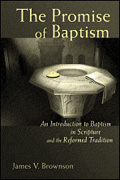
James V. Brownson
Reviewed by: Chad E. Bond
The Promise of Baptism: An lntroduction to Baptism in Scripture and the Reformed Tradition, by James V. Brownson. Published by Eerdmans, 2007. Paperback, 223 pages, list price $16.00. Reviewed by OP pastor Chad E. Bond.
Brownson's The Promise of Baptism is clearly organized, well written, and fairly easy to digest. Each of its thirty short chapters is focused on a specific question and concludes with a helpful summary, discussion guide, and suggestions for further study. The book also includes an annotated bibliography and a Scripture index.
In the opening section, Brownson sets an overall context for thinking about baptism by dealing with such foundational questions as: What does it mean to be a Christian? What is the church? What is a sacrament and how does it differ from an ordinance? Why are sacraments necessary and important?
In section 2, the core meanings and proper mode of baptism are discussed: What does Romans 6:3 mean when it j speaks of being "baptized into Christ's death"? What is the relationship between baptism and being "born again"? Which is better, sprinkling or immersion?
The issues in section 3 revolve around how baptism, faith, and salvation relate to each other: Does baptism presuppose faith, or does it call us to faith? Can someone be saved without being baptized? Does baptism actually bring about any change in us?
Section 4 argues persuasively for covenantal infant baptism. Brownson lays out a good case for interpreting the entire Bible as expressive of a single covenant purpose of God, examines the place of families in it, demonstrates the relationship between baptism and circumcision, and discusses the theological basis for the possibility of infant salvation.
Section 5 effectively dismantles several objections to paedobaptism.
In the last section, Brownson addresses questions that church leaders commonly face. For example: What about infant dedication instead of baptism? What about rebaptism? What invalidates a baptism? Should infants of believing grandparents, but not believing parents, be baptized?
The book concludes with a chapter entitled "What Happens after Baptism?" Here Brownson urges one to think about baptism "not as the end of the salvation road, but as the beginning of the discipleship road." According to him, the "central challenge in living out our baptism is to remember who we are, and whom we are following, as disciples of Christ." But this is not an exclusively individual matter, for church members are sustained in their baptismal identity only through the preaching of the Word, the use of the sacraments, and the discipline and practices of the church.
Sifting through this book requires a certain level of discernment. It is apparent throughout the book that Brownson's own theological sympathies align more with Reformed mainline moderatism than Old School confessional Calvinism. Even his working definitions of such rudimentary terms as sin, salvation, and the church leave a lot to be desired.
In the final analysis, wisdom would dictate that The Promise of Baptism should not be used as the primary text for the instruction of initiates. In this reviewer's opinion, John Murray's Christian Baptism remains the gold standard. Nevertheless, the more discerning reader will find much in this book that is instructive, insightful, and illuminating.
March 30, 2025
On the Trail with a Missionary
March 23, 2025
Midnight Mercies: Walking with God Through Depression in Motherhood
March 16, 2025
March 09, 2025
Zwingli the Pastor: A Life in Conflict
March 02, 2025
February 23, 2025
African Heroes: Discovering Our Christian Heritage
February 16, 2025
© 2025 The Orthodox Presbyterian Church